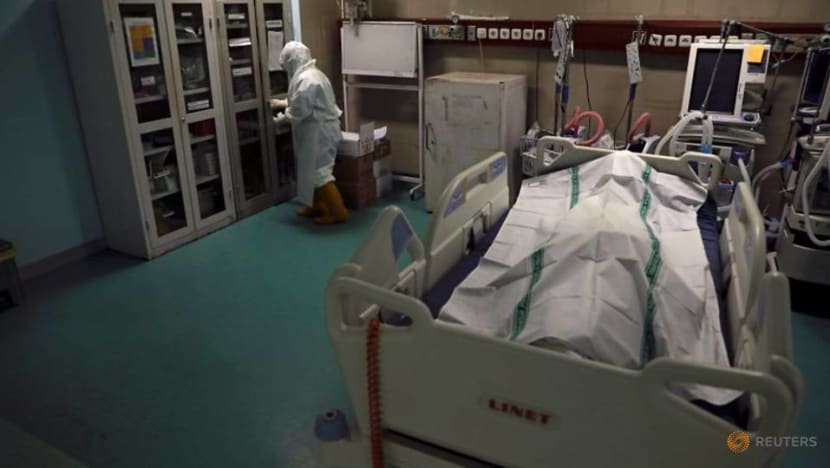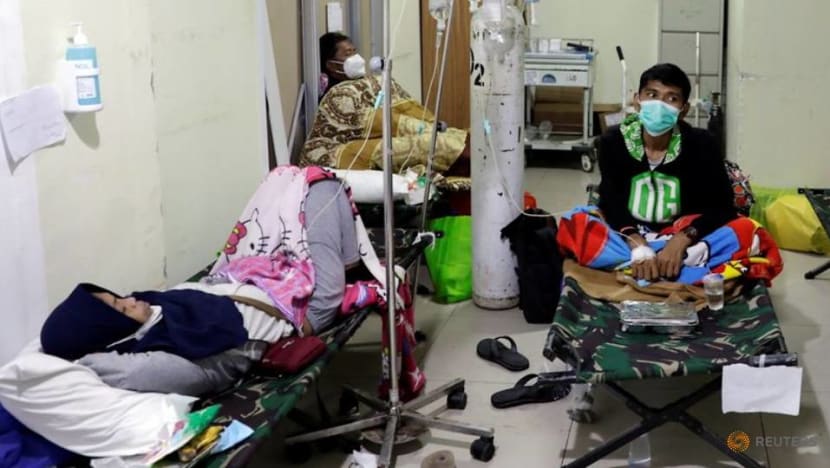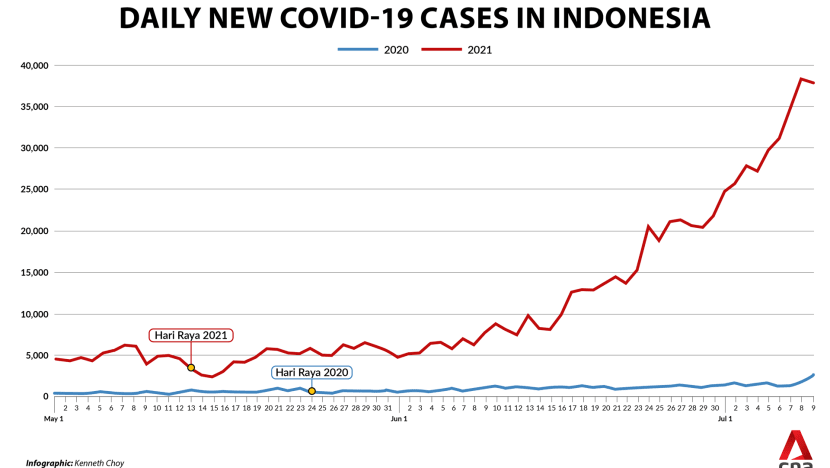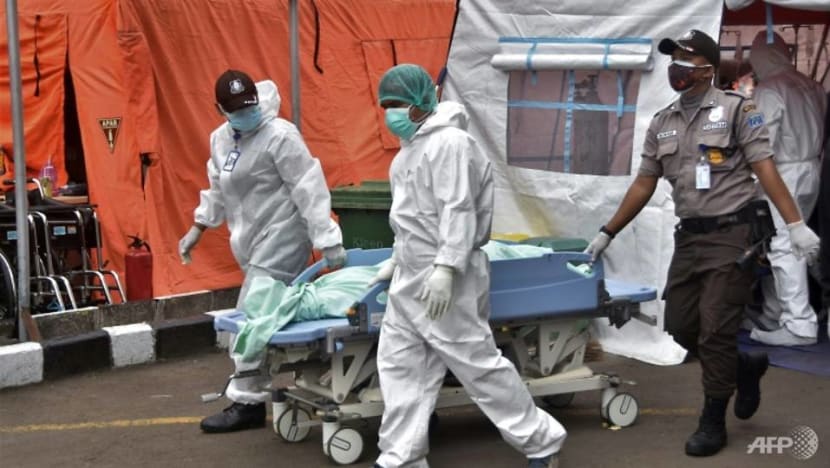What might have caused the huge spike in Indonesia's COVID-19 cases post-Idul Fitri holiday

FILE PHOTO: A nurse works at the ICU ward for COVID-19 patients as a body of a 28-year-old woman lies on a bed waiting to be transferred to a mortuary room, at a government-run hospital in Jakarta, Indonesia, June 29, 2021. REUTERS/Willy Kurniawan
JAKARTA: Indonesia has been grappling with a surge in COVID-19 infections for the past few weeks, consistently recording more than 30,000 new daily cases.
On Friday (Jul 9), the country reported 38,124 cases. There are now more than 2.4 million infections and over 64,000 deaths.
The spike came after Idul Fitri’s holiday in mid-May where people were said to have returned to their hometowns despite a travel ban and crowds filled tourist spots.
The government had anticipated a hike in COVID-19 cases as last year's Idul Fitri’s holiday led to an increase of about 60 to 70 per cent of infections.
Thus they added up to 72,000 isolation beds, about 20,000 of which were already occupied before the holiday.
A total of 7,500 intensive care unit beds, of which around 2,000 were occupied before Idul Fitri, were also added.
However, this year’s post-Idul Fitri COVID-19 cases spike is significantly higher than last year’s.

This year, several regions have seen an increase of more than 200 per cent, leading many hospitals to be under severe strain.
Coordinating Minister for Maritime Affairs and Investment Luhut Pandjaitan even admitted on Thursday (Jul 1) the government did not expect the spike would be so high.
The government’s spokeswoman for COVID-19 handling and vaccination Siti Nadia Tarmizi told CNA that one reason for this drastic increase was people taking the health protocols more lightly nowadays.

Another reason was the presence of the new COVID-19 variants.
Experts interviewed by CNA believed the highly contagious Delta variant, which did not exist last year, played a significant and dominant role in the influx of COVID-19 cases.
"It is proven everywhere in the world that this Delta variant virus is very, very easily transmittable,” said Professor Zubairi Djoerban, head of the COVID-19 task force at the Indonesian Medical Association.
READ: Indonesia's COVID-19 situation nears 'catastrophe', says Red Cross
Nevertheless, the experts noted that multiple factors contributed to the current dire condition.
Factors such as the return of migrant workers from overseas at the same time when people ignored a travel ban in the lead-up to the Idul Fitri holiday, short quarantine period and weak tracing and testing also played a role, they said.
DELTA IS RAGING
Prof Djoerban said that because the Delta strain is more dangerous compared to the initial variant of COVID-19, those who are infected with Delta tend to need treatment at a hospital.
“That's why all the hospitals are now full,” he said.

He also said that previously people who have been infected by COVID-19 would develop an antibody after they have recovered.
However, the antibodies developed by the previous strains do not seem to offer much protection against the Delta variant.
“So there are some people who already got COVID-19 but then got reinfected,” he said.
Prof Djoerban noted that people who have been vaccinated can still be infected by the Delta variant, even though the proportion of that in Indonesia is not high at the moment.
“That’s why after vaccination we shouldn’t be euphoric and feel overconfident. We still need to obey health protocols,” he added.
READ: Malls shut, dining-in banned as Indonesia unveils broad emergency COVID-19 curbs in Java and Bali
Dr Dwi Bambang, also believed that the new variants - including Delta - is a contributing factor to the current situation.
The pulmonologist who works at three different hospitals in Central Java’s capital Semarang said that he now has more patients compared to last year.
“The wards are all full ... getting an ICU with a ventilator is hard, and there are many in the emergency rooms whose (oxygen) saturation is declining,” said Dr Bambang.
While most of his patients are 35 to 60 years old, he also had a COVID-19 patient who was four years old.
LENGTH OF QUARANTINE PERIOD IS AN ISSUE
The Delta variant is believed to have entered Indonesia from people who arrived from overseas.
Epidemiologist Dr Atik Choirul Hidajah said apart from many people travelling to their hometowns last May, there were also many Indonesian migrant workers who returned from abroad.
Dr Hidajah said that conceptually an infectious disease consists of three elements namely the host, the agent and the environment.
READ: Jokowi aims to vaccinate 7.5 million Jakartans by end August, but experts say herd immunity is not a given
When talking about COVID-19, the host is people and the agent is the virus.
The environment is the physical environment such as rooms with ventilation as well as regulations to curb the spread of the virus.
“The host during the Idul Fitri period was the people who went on an exodus to meet their family and acquaintances, but we must also remember that not only those people were the ones who travelled domestically for Idul Fitri.
“There were also many migrant workers who arrived from abroad,” she said.
Although it is mandatory for anyone who arrives in Indonesia to show a negative PCR test, the enforcement may not always be strict, said the epidemiologist from Surabaya’s Airlangga University.
Until Monday, new arrivals would have to undergo quarantine for five days, but Dr Hidajah said the normal incubation period of COVID-19 is 14 days.
The quarantine period is 14 days for arrivals from India, Pakistan and the Philippines has only been imposed since April.
But even with the 14-day quarantine regulation, the police caught some arrivals from India violating the regulation at the end of April.

Dr Masdalina Pane, head of the Professional Development Division of the Indonesian Association of Epidemiology Experts (PAEI), concurred that the five-day quarantine period is too short and it has contributed to the spike in recent cases.
“The quarantine period shouldn’t be five days, it should be 14 days,” said Dr Pane.
“I believe this is why the cases continue to climb, apart from the (emergence of) Delta variant.”
Last weekend, the government said that the quarantine period for new arrivals in Indonesia would be extended to eight days starting Jul 6.
CONTACT TRACERS WERE REDUCED
Another factor contributing to the rise in recent cases is the fact that the government has reduced the number of contact tracers a few months ago, said Dr Pane.
Back in January, the task force recruited 8,000 tracers in 59 regencies as well as cities following a spike believed to have resulted from the Christmas and New Year’s holidays. These places were highlighted because they contributed to 70 per cent of the infections in the country.
But the number of tracers were reduced at the end of March, Dr Pane said, after the infection rate started to decline.
“The main essence of tracing is containment, disciplined isolation and quarantine,” said Dr Pane, who is also a member of the national COVID-19 task force tracing subdivision.
READ: Jokowi says Sinovac COVID-19 vaccination can begin for those aged 12 to 17 immediately
Dr Hidajah in Surabaya said that they have conducted research and their latest data as of the end of June showed that the tracing ratio is 1:10, while the standard should be at least 1:30.
This means that for one person who is COVID-19 positive, only about 10 close contacts were traced.
“Because the suspects have not been traced, so there is no testing. And if people are not tested, they cannot be treated.
“So we should enhance this. And there are many regions which have limited labs.”

Thus, she suggested recruiting more tracers.
She further noted that suspected patients should be isolated at home but nobody can guarantee that people actually stay at home.
If the tracing and testing are still limited and the quarantine period remains short, both epidemiologists said the infection rate will not decline.
The health minister had said that Indonesia would see a peak in COVID-19 cases at the end of June or early July, but case numbers have continued to rise so far. For Dr Pane, the worst is yet to come.
“Previously, the peak in January was lowered by intervention (with active contact tracing). If there is no intervention now, cases will continue to rise, many will be infected,” she said.
BOOKMARK THIS: Our comprehensive coverage of the coronavirus outbreak and its developments
Download our app or subscribe to our Telegram channel for the latest updates on the coronavirus outbreak: https://cna.asia/telegram












